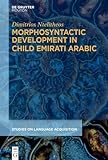Morphosyntactic Development in Child Emirati Arabic / Dimitrios Ntelitheos.
Material type: TextSeries: Studies on Language Acquisition [SOLA] ; 63Publisher: Berlin ; Boston : De Gruyter Mouton, [2024]Copyright date: 2024Description: 1 online resource (VIII, 202 p.)Content type:
TextSeries: Studies on Language Acquisition [SOLA] ; 63Publisher: Berlin ; Boston : De Gruyter Mouton, [2024]Copyright date: 2024Description: 1 online resource (VIII, 202 p.)Content type: - 9781501520198
- 9781501513824
- 9781501513794
- Arabic language -- Acquisition
- Arabic language -- Dialects -- United Arab Emirates -- Acquisition
- Arabic language -- Dialects -- United Arab Emirates -- Grammar
- Children -- United Arab Emirates -- Language
- Arabisch
- Entwicklungsphase
- Erstspracherwerb
- Golf-Arabisch
- Spracherwerb
- LANGUAGE ARTS & DISCIPLINES / Linguistics / General
- Child Language Acquisition
- Developmental Stages
- Emirati Arabic
- First Language Acquisition
- Longitudinal Study
- 492.7/7095357 23/eng/20240919
- PJ6859 .N84 2024
- online - DeGruyter
- Issued also in print.
| Item type | Current library | Call number | URL | Status | Notes | Barcode | |
|---|---|---|---|---|---|---|---|
 eBook
eBook
|
Biblioteca "Angelicum" Pont. Univ. S.Tommaso d'Aquino Nuvola online | online - DeGruyter (Browse shelf(Opens below)) | Online access | Not for loan (Accesso limitato) | Accesso per gli utenti autorizzati / Access for authorized users | (dgr)9781501513794 |
Frontmatter -- Acknowledgements -- Contents -- 1 Data Sources and Theoretical Assumptions -- 2 Acquisition of Arabic: State of the Art -- 3 A Brief Sketch of Emirati Arabic Grammar -- 4 Language Growth in Child EA -- 5 Definiteness in Child EA -- 6 Possessive Structures in EA -- 7 Verb Inflection -- 8 Negation -- 9 Word Order -- 10 Concluding Remarks and Future Directions -- References -- Index
restricted access online access with authorization star
http://purl.org/coar/access_right/c_16ec
This book investigates selected aspects of the grammatical development of Emirati Arabic, the variety of Gulf Arabic spoken in the United Arab Emirates and closely related to the varieties spoken in the rest of the Gulf States. While the acquisition of Arabic as a second language has been widely studied, first language acquisition of different Arabic dialects has received much less attention. Ntelitheos addresses this disparity by presenting a number of systematic studies on the acquisition of Emirati Arabic grammar based on a two-year longitudinal corpus of six children. He discusses the acquisition of the nominal domain, including definiteness and possession; the acquisition of verbal functional structure and agreement; and the acquisition of word order and negation in the syntactic domain. In addition, he defines several developmental stages for Emirati Arabic, based on established diagnostic tests. The discussion is framed within a general survey of the relevant literature in Arabic acquisition studies and combines new empirical data with rigorous discussion of several long-standing theoretical problems in the broader field of child language development.
Issued also in print.
Mode of access: Internet via World Wide Web.
In English.
Description based on online resource; title from PDF title page (publisher's Web site, viewed 20. Nov 2024)


